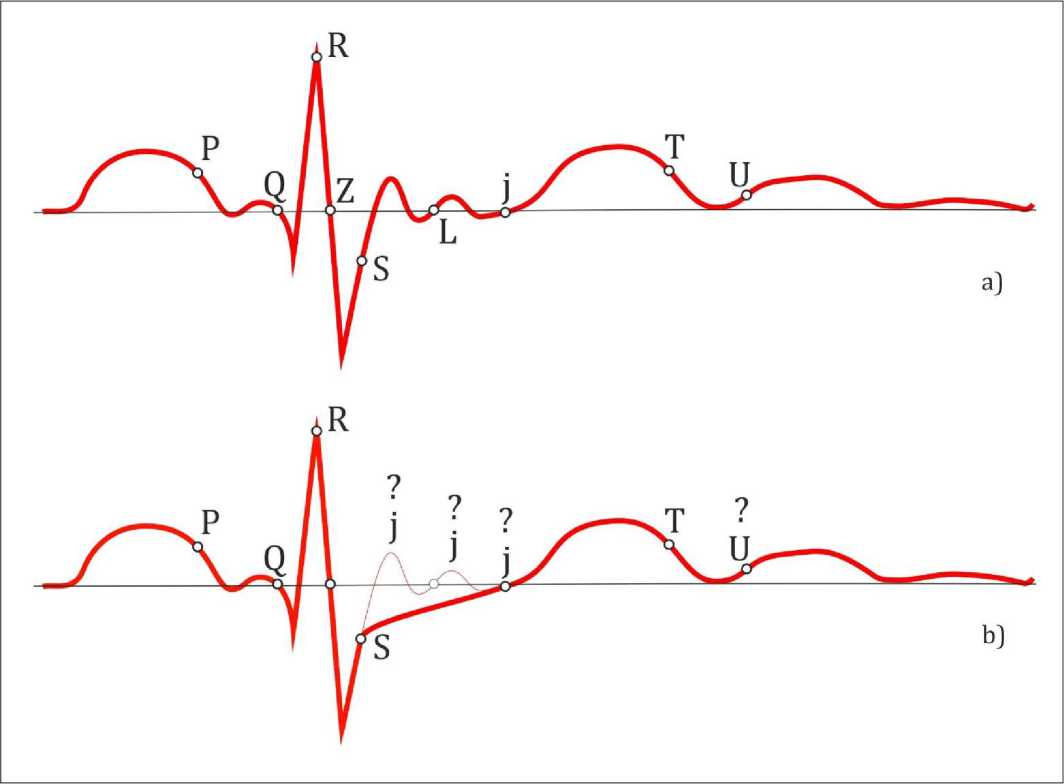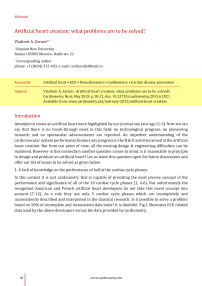Artificial heart creation: what problems are to be solved?
Автор: Zernov Vladimir A.
Журнал: Cardiometry @cardiometry
Рубрика: Editorial
Статья в выпуске: 6, 2015 года.
Бесплатный доступ
ID: 148308794 Короткий адрес: https://sciup.org/148308794
Текст ред. заметки Artificial heart creation: what problems are to be solved?
Cardiometry; No.6; May 2015; p.18-21; doi: 10.12710/cardiometry.2015.6.1821 Available from:
-
1. A lack of knowledge on the performance of half of the cardiac cycle phases.
In this context it is just cardiometry that is capable of providing the most precise concept of the performance and significance of all of the 10 cardiac cycle phases [1, 4-6]. But unfortunately the recognized American and French artificial heart developers do not take this novel concept into account [7-12]. As a rule they use only 5 cardiac cycle phases which are incompletely and inconsistently described and interpreted in the classical research. Is it possible to solve a problem based on 50% of incomplete and inconsistent data basis? It is doubtful. Fig.1 illustrates ECG related data used by the above developers versus the data provided by cardiometry.

Figure 1. Identification of the boundaries in each cardiac cycle phase based on the laws of cardiometry (a) or by ignoring them and using generally accepted concepts (b): point L to indicate the beginning of the rapid ejection phase cannot be identified; the location of the j point as the beginning of the slow ejection phase cannot be found; significance of the U wave as the interval of the coronary blood flow filling is not understood. Cardiometry is capable of accurately identifying all the phase boundaries and properly locating all significant points on the ECG.
The knowledge on the cardiac cycle phase pattern is build upon the relevant axiomatic and logic system. And it is the basis for any science, including cardiometry. Moreover, cardiometry offers its own original mathematical description of all hemodynamic processes in a human body. It is just the thing that is urgently required for the American and French scientists who are involved in research and development of artificial heart. The above figure shows the ST segment ST on the ECG which consists of four most important systolic phases. In fact the conventional cardiology is not capable of delivering such valuable information. Ignoring the valuable information is the most critical deterrent to make progress in engineering of artificial heart.
This problem did not appear at once. Victor Froelicher and John P.A. Ioannidis have clearly defined the problematic topics in their papers [13, 14]. Our intention is to suggest new ways how to handle this challenging task in research [3, 4].
The latest research results and methodology initiate re-consideration and re-evaluation of the existing expertise. The same is applicable to our case with cardiology and cardiometry. Upon the fresh expertise, taking into account original comprehensive capabilities in the modern cardiac diagnostics, we are inclined to believe that it is not reasonable to create artificial heart today and that we should pay more attention to cardiac disease prevention and treatment. Following this way, it is vital to establish a system of preventive children’s cardiology based on monitoring, screening and effective correction measures. We should address interdependence between the heart performance and health as a whole. Every effort should be made to maximize the health of children because children’s health is a prerequisite for the future nation’s wealth. As our practice shows, unfortunately, not so many healthcare officers share this opinion. And sometimes some health care officers think the creation of an artificial heart will automatically resolve all the health care problems.
We are very interested to hear our readers’ opinion: what advantages does the artificial heart creation have? Or is it better to improve the efficiency of diagnostics and prevention instead?
Список литературы Artificial heart creation: what problems are to be solved?
- Rudenko MY, Krstacic G. New philosophy of validation and verification for cardiology: classical proof theory imported from natural sciences. Cardiometry. 2014;4:16-30 DOI: 10.12710/cardiometry.2014.4.1630
- Rudenko MY, Voronova OK, Zernov VA. ECG periodic table: a new ECG classification based on heart cycle phase analysis. Cardiometry. 2013;2:19-28.
- Rudenko MY, Zernov VA, Mamberger KK, Rudenko SM. Heart and aortic baroreceptors: operation in providing hemodynamic processes in cardiovascular system. Cardiometry. 2013;3:31-44.
- Rudenko MY, Voronova OK, Zernov VA. Theoretical Principles of Heart Cycle Phase Analysis. Frankfurt a/M, Munich, London, New York: Fouqué Literaturverlag; 2009. 336 p. ISBN 9783937909578.
- Rudenko MY, Zernov VA, Voronova OK. Study of hemodynamic parameters using phase analysis of the cardiac cycle. Biomedical Engineering. 2009;43(4):151-5.
- Rudenko MY, Zernov VA, Voronova OK. Fundamental research on the mechanism of cardiovascular system hemodynamics self-regulation and determination of the norm-pathology boundary for the basic hemodynamic parameters and analysis of the compensation mechanism as a method of revealing the underlying causes of disease. Heart Rhythm. 2012;9(11):1909-10.
- Verbovaia TA, Gritsenko VV, Davydenko VV, et al. On the history of creation and introduction of the first compact artificial heart valves in Russia. Vestnik khirurgii imeni I. I. Grekova. 2009;168(3):94-7.
- Spiliopoulos S, Koerfer R, Tenderich G. A first step beyond traditional boundaries: Destination therapy with the SynCardia total artificial heart. Interactive Cardiovascular and Thoracic Surgery. June 2014;18(6):855-6.
- Torregrossa G, Morshuis M, Varghese R. Results with syncardia total artificial heart beyond 1 year. ASAIO Journal. 2014;60(6):626-34.
- Slepian MJ, Alemu Y, Soares JS. The Syncardia™ total artificial heart: In vivo, in vitro, and computational modeling studies. Journal of Biomechanics. 18 January 2013;46(2):266-75.
- Ménard J. Keys to the success of the CARMAT project? Medecine/Sciences. February 2014;30(2):204-5.
- Arabia FA, Moriguchi JD. Machines versus medication for biventricular heart failure: Focus on the total artificial heart. Future Cardiology. 1 September 2014;10(5):593-609.
- Yong CM, Froelicher V, Wagner G. The electrocardiogram at a Crossroads. Circulation. 2013;128:79-82 DOI: 10.1161/CIRCULATIONAHA.113.003557
- Ioannidis JPA. How to make more published research true. PLoS Med. 2014;11(10): e1001747 DOI: 10.1371/journal.pmed.1001747


